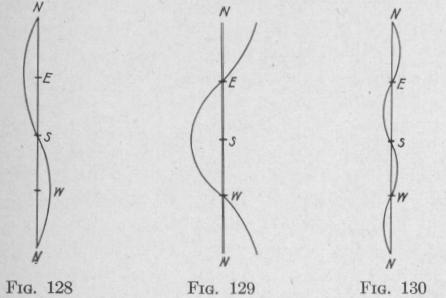166 NAVIGATIONAL COMPASSES
line is an irregular curve which in the western hemisphere extends from longitude about 96° W., at latitude 70° N., to longitude about 28° W., at latitude 70° S.; and in the eastern hemisphere extends from longitude about 28° E., at latitude 70° N., to longitude about 138° E., at latitude 70° S. A compass needle on an agonic line places itself in the geographic meridian, that is, points true north and south. At various places on the earth, a compass needle that is uninfluenced by any magnetic field except that of the earth will show declinations as great as 180 degrees. In the state of Maine the compass points about 25 degrees west of the geographic meridian, and in the state of Washington it points to the east an equal amount. The compass declination at any point on the earth changes with time. At New York harbor the declination now is about 11 degrees and is increasing at the rate of 6 minutes per year. The magnetic declinations are known for all parts of civilized lands and navigated areas. They are not known, however, for large areas within the arctic and antarctic zones.
The directive tendency of a magnetic compass depends upon the magnitude of the horizontal component of the earth's magnetic field. At no place within either the arctic or the antarctic zone is the horizontal component greater than about one-half the value in New York. Within considerable areas it is nearly zero.
100. The Deviations of a Magnetic Compass or. an Iron Ship. - While a ship is being built, the magnetic field of the earth causes the iron structure to become a big magnet with the north-seeking pole toward the north. The various hammering operations facilitate the magnetic induction. If the ship is heading north while being built, there will be developed a north-seeking pole at the lower part of the bow and a south-seeking pole at the upper part of the stern. The steel parts of the ship will retain a part of this magnetism after the ship is launched and is pointing in any direction. A ship that was built with the keel north and south will give no deviations due to this subpermanent magnetism when pointing either north or south. As the ship is rotated 360 degrees, the compass will deviate to the east in one semicircle and westerly in the other (Fig. 128). Deflections of the compass from the magnetic meridian due to this cause are called semicircular deviations. In many cases, semicircular deviations amount to as much as 20 degrees. The semicircular deviation of a compass changes with change of geographical position. If the bow of the ship has been toward the east when building, a north-seeking pole would be
THE VARIOUS TYPES 167
developed on the port side. The permanent magnetism of the steel of the ship would give deviations represented by Fig. 129.
The soft iron of a ship becomes magnetized by the earth's magnetic field in which it is situated. As a ship is headed in different directions, the magnetic poles induced in horizontal masses of iron change their position relative to the ship. The compass deviations due to this temporary magnetism are easterly while the head of the ship is pointing in the quadrant from magnetic
north to east (Fig. 130), and also while the ship is pointing from magnetic south to west. They are westerly while the ship is pointing from east to south and also when it is pointing from west to north. These deviations are called quadrantal deviations. In many cases, quadrantal deviations are as much as 10 degrees. The quadrantal deviation of a compass depends upon the direction of the fore-and-aft axis of the ship relative to the magnetic meridian at the place where the ship is situated.
When an iron ship either rolls or pitches, the compass is affected by changes in the vertical induction of elongated soft iron masses as well as by changes at the compass of the subpermanent magnetic field of the steel parts of the ship. This so-called " heeling error " may amount to more than one degree of compass deviation per degree rolling or pitching of the ship.
A large part of the total deviation of the compass due to fixed masses of iron and steel can be eliminated by properly placed bar magnets, soft iron rods and spheres in the neighborhood of the needle. The residual deviations can be determined experimentally and plotted on a curve for the use of the navigator. However, as the direction and intensity of the earth's field are subject to
